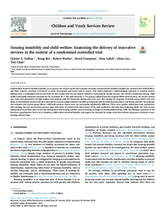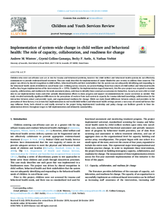Displaying 921 - 930 of 2503
The objective of this study was to examine the utility of child protective services data in identifying predictors of placement disruption.
In this opinion piece for the Chronicle of Social Change, Theresa Covington, the director of the Within Our Reach office at the Alliance for Strong Families and Communities and the director of the National Center for Fatality Review and Prevention, describes the need for better data sharing to prevent child maltreatment fatalities in the United States.
This research examined the impact of individual and relational characteristics of foster parents on permanency outcomes for children in care.
This study employed a mixed-methods approach to examine process findings from a randomized control trial from the first county-level Pay for Success initiative, Partnering for Family Success.
Children who enter out-of-home care are at risk for trauma and behavioral problems, however the child welfare and behavioral health systems do not effectively communicate to provide evidenced-based treatment. This case study describes a project that addressed these concerns.
The Convention on the Rights of the Child was adopted by the UN General Assembly on 20 November 1989. In the lead-up to the Convention’s 30th birthday, a series of events will be organized in celebration.
In this webinar, the National Family Support Network and Be Strong Families will join together to provide an overview of the value of Parent Leadership opportunities for both programs and parents/caregivers. The organizations will detail resources, tools, technical assistance, and trainings they have available to support meaningful parent leadership development, including the Developing and Sustaining Effective Parent Advisory Committees Training and Parent Cafes.
In this opinion piece for the Chronicle of Social Change, Dr. Ali Caliendo (the executive director of Foster Kinship, a nonprofit organization devoted to the support of kinship families in the U.S. state of Nevada) outlines her recommendations for child welfare systems to improve outcomes for children by adopting best practices in supporting kinship families.
The purpose of this study was to examine factors related to unintentional child injury requiring medical attention, including child welfare placement type, child behavioral problems, caregiver characteristics, and neighborhood factors.
This chapter from the book Education in Out-of-Home Care describes trends in the secondary and postsecondary educational attainment of care-experienced young people in the California Youth Transitions to Adulthood Study (CalYOUTH), support they received to pursue their education, and the obstacles they have encountered along the way.


